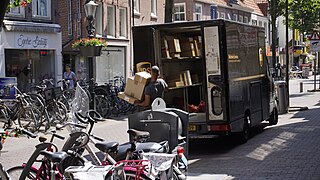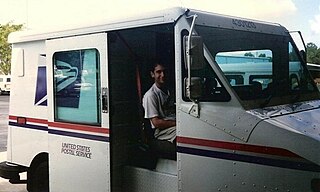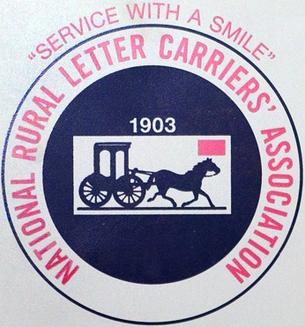
A post office is a public facility and a retailer that provides mail services, such as accepting letters and parcels, providing post office boxes, and selling postage stamps, packaging, and stationery. Post offices may offer additional services, which vary by country. These include providing and accepting government forms, and processing government services and fees. The chief administrator of a post office is called a postmaster.

The United States Postal Service (USPS), also known as the Post Office, U.S. Mail, or simply the Postal Service, is an independent agency of the executive branch of the United States federal government responsible for providing postal service in the United States, its insular areas and associated states. It is one of a few government agencies explicitly authorized by the Constitution of the United States. As of 2023, the USPS has 525,469 career employees and 114,623 non-career employees.

The United States Post Office Department was the predecessor of the United States Postal Service, established in 1792. From 1872 to 1971, it was officially in the form of a Cabinet department. It was headed by the postmaster general.
Canada Post Corporation, trading as Canada Post, is a Canadian Crown corporation that functions as the primary postal operator in Canada.

Package delivery or parcel delivery is the delivery of shipping containers, parcels, or high-value mail as single shipments. The service is provided by most postal systems, express mail, private courier companies, and less-than-truckload shipping carriers. Package delivery is different in each country, and how packages are delivered is closely connected with the cost for delivering to that country as well as population. In 2019, China, The United States, and Japan were the leaders in package delivery while Latvia, Macau, and Iceland were the bottom three. The population of the bottom three barely totals 2 million while the population of the top three tops totals more than 2 billion. Package delivery is an every day occurrence in the US while many other countries do not have this luxury.

A mail carrier, also referred to as a mailman, mailwoman, mailperson, postal carrier, postman, postwoman, postperson, person of post, letter carrier, or colloquially postie, is an employee of a post office or postal service who delivers mail and parcel post to residences and businesses. The term "mail carrier" came to be used as a gender-neutral substitute for "mailman" soon after women began performing the job. In the Royal Mail, the official name changed from "letter carrier" to "postman" in 1883, and "postwoman" has also been used for many years.
In a postal system, a delivery point is a single mailbox or other place at which mail is delivered. It differs from a street address, in that each address may have several delivery points, such as an apartment, office department, or other room. Such buildings are often called multiple-dwelling units (MDUs) by the USPS.

A post office box is a uniquely addressable lockable box located on the premises of a post office.

A letter box, letterbox, letter plate, letter hole, mail slot or mailbox is a receptacle for receiving incoming mail at a private residence or business. For outgoing mail, post boxes are often used for depositing the mail for collection, although some letter boxes are also capable of holding outgoing mail for a carrier to pick up. Letterboxes or mailboxes use the following primary designs:
Rural delivery service refers to services for the delivery of mail to rural areas.
The UPS Store is a franchised subsidiary of United Parcel Service which provides, according to its website, shipping, shredding, printing, fax, passport photos, personal and business mailboxes, and notary services.

The National Association of Letter Carriers (NALC) is an American labor union, representing non-rural letter carriers employed by the United States Postal Service. It was founded in 1889. The NALC has 2,500 local branches representing letter carriers in all 50 states, the District of Columbia, Puerto Rico, the Virgin Islands and Guam.

Rural letter carriers are United States Postal Service and Canada Post employees who deliver mail in what are traditionally considered rural and suburban areas of the United States and Canada. Before Rural Free Delivery (RFD), rural Americans and Canadians were required to go to a post office to get their mail.

The National Rural Letter Carriers' Association (NRLCA) is an American labor union that represents the rural letter carriers of the United States Postal Service (USPS). The NRLCA negotiates all labor agreements for the rural carrier craft with the USPS, including salaries, and represents members of the rural carrier craft in the grievance procedure. The NRLCA's stated goal is to "improve the methods used by rural letter carriers, to benefit their conditions of labor with the United States Postal Service, and to promote a fraternal spirit among its members."
Centralized mail delivery is a unique form of mail delivery system where a letter carrier provides delivery and collection services to a number of residences from a centrally located installation – whether in a single-family subdivision or multi-family structure. Business customers also receive delivery services from a convenient central location. Centralized mail delivery equipment can be in the form of any "clustered" type mailbox – including free-standing, pedestal-mounted cluster box unit (CBU), or other cluster mailboxes mounted in a wall, kiosk, or shelter. The U.S. Postal Service prefers centralized mail delivery in all new construction because it is less expensive. The United States Postal Service aims to continue to review and modify its operations to provide universal service as efficiently and cost effectively as possible. Therefore, there is pressure to establish centralized mail delivery, which is required in some communities.
STD-4C or STANDARD-4C refers to a set of standards and regulations set by the United States Postal Service regarding the specifications of cluster mailbox units used in new construction. All multi unit constructions building plans submitted after October 6, 2006 are required to use STD-4C compliant mailboxes

The U.S. Parcel Post stamps of 1912–13 were the first such stamps issued by the U.S. Post Office Department and consisted of twelve denominations to pay the postage on parcels weighing 16 ounces and more, with each denomination printed in the same color of "carmine-rose". Their border design was similar while each denomination of stamp bore its own distinctive image in the center (vignette). Unlike regular postage items, whose rates were determined by weight in ounces, Parcel Post rates were determined and measured by increments in pounds. The new stamps were soon widely used by industry, farmers and others who lived in rural areas. Partly owing to some confusion involving their usage, their exclusive use as Parcel Post stamps proved short lived, as regular postage stamps were soon allowed to be used to pay parcel postage rates.

An arrow lock is a lock with standard dimensions used by the United States Postal Service for mail carriers to access collection boxes, outdoor parcel lockers, cluster box units, and apartment mailbox panels. Arrow locks are unlocked through the use of a corresponding arrow key. Arrow locks are also referred to as "Master Access Locks"

A fourth-class post office in the United States, from 1864 to the 1970s, was a post office at which the postmaster received the lowest tier of annual commission income from postage stamps. Prior to the early 20th century, fourth-class post offices were the backbone of the U.S. postal system. They were also in many cases the backbones of the hamlets and rural communities where they were located, as they provided a local gathering place and center of civic activity. These small rural post offices followed an agency model, in which the Post Office Department used existing buildings and businesses and paid its postmasters on a commission basis.














